PWT Male Y — Professional Guide to the One-Touch Pneumatic Push-Fit Fitting for Confined Installations
The PWT Male Y is a high-performance one-touch pneumatic fitting engineered for fast, tool-free connection and disconnection of tubing in compressed-air systems. Designed specifically for installations where space is constrained, the PWT Male Y combines a compact profile, a hex-shaped PC type for wrench access in tight locations, and seal-coated threads for simplified assembly. This article provides a comprehensive technical overview, specifications, materials and build quality assessment, installation and maintenance guidance, application examples, comparative analysis, and a balanced discussion of benefits and limitations.
Introduction
Pneumatic systems rely on reliable, leak-free connections that are easy to assemble and maintain. The PWT Male Y meets those needs by offering a push-fit, one-touch design suitable for a wide range of metric and imperial tubing sizes and thread standards. Its quick-release sleeve enables connection or removal in 1–2 seconds without tools, minimizing downtime for maintenance or reconfiguration. The compact, hex-profiled PC type is optimized for confined pipes and manifolds where conventional fittings are difficult to install.
This technical article is intended for system designers, maintenance technicians, procurement specialists, and engineers evaluating quick-connect fittings for compressed-air distribution and machine pneumatic control circuits.
Technical Overview
The PWT Male Y is a push-in / one-touch male-threaded fitting engineered for compressed air applications (intended fluid: compressed air only). The fitting combines three principal functional elements:
- Push-fit Connector — A collar or collet with internal gripping teeth that secures tubing when fully inserted; an internal sealing mechanism (O-ring) creates the pressure-tight seal.
- Quick-Release Sleeve — Depressing the sleeve releases the collet grip and permits rapid tubing removal without tools.
- Male Thread Interface — A threaded male end for attachment to ports, manifolds, valves or adapters. Threaded portions are supplied with a factory-applied seal coating to ensure immediate leak-free installation and to reduce the need for additional pipe sealant.
Key design emphasis:
- Repeatable, tool-free make/break cycles (rapid maintenance, reconfiguration)
- Optimized form factor (PC type hex profile) for confined or recessed installations
- Compatibility across a broad range of tubing diameters and thread standards
- Engineered sealing and collet design for secure retention under specified pressure and vacuum conditions
Operating Parameters
The PWT Male Y specification envelope supports typical pneumatic system conditions and vacuum handling for evacuation tasks:
- Operating pressure: 0–150 PSI (0–9.9 kgf/cm², approx. 0–990 kPa)
- Vacuum rating: down to -29.5 in Hg (-750 mm Hg, approx. 10 Torr)
- Operating temperature range: 0–60°C (32–140°F)
- Intended fluid: compressed air only (oil-lubricated air generally acceptable; consult manufacturer for compatibility with special fluids)
Specifications and Dimensions
The following tables collate the typical technical attributes and a representative dimension set for the PWT Male Y series. The product is sold in multiple variants to accommodate metric and inch tubing sizes, and various thread forms (BSPP, BSPT, NPT, Metric). Values shown are typical ranges and representative model dimensions; refer to manufacturer datasheets for exact part-level drawings and tolerances.
| Attribute | Value / Range |
|---|---|
| Intended Fluid | Compressed air only |
| Operating Pressure | 0–150 PSI (0–9.9 kgf/cm², ~0–990 kPa) |
| Maximum Vacuum | -29.5 in Hg (-750 mm Hg, ~10 Torr) |
| Operating Temperature | 0–60°C (32–140°F) |
| Available Tube Sizes (Metric) | Ø4, Ø6, Ø8, Ø10, Ø12, Ø16 mm |
| Available Tube Sizes (Imperial) | 5/32″, 3/16″, 1/4″, 5/16″, 3/8″, 1/2″ |
| Typical Thread Types | 1/8″, 1/4″, 3/8″, 1/2″ BSPP/BSPT/NPT, Metric threads (e.g., M5, M10), specialized industrial threads |
| Seal System | Elastomer O-ring (standard: NBR) with factory-applied thread seal coating |
| Typical Body Material | Nickel-plated brass (standard); stainless steel variants for corrosive environments |
| Collet Material | Stainless steel teeth with POM/acetal or brass release sleeve |
| Sleeve Material (PC type) | Machined metal with hex-shaped internal/external profiles (hex), polymer-coated options available |
| Typical Cv Range (approx.) | Ø4 mm: 0.06–0.10; Ø6 mm: 0.12–0.25; Ø8 mm: 0.25–0.45; Ø10 mm: 0.4–0.65; Ø12 mm: 0.7–1.0; Ø16 mm: 1.0–1.6 |
Representative Dimensional Table (Example Models)
The following table shows representative dimensions for common models. These are example dimensions; verify against product drawings for precise installations.
| Model | Tube OD | Thread | Overall Length (L) | Hex Size (across flats) | Approx. Weight |
|---|---|---|---|---|---|
| PWT04-1/8 | Ø4 mm | 1/8″ BSPP | 21 mm | 10 mm | 6 g |
| PWT06-1/8 | Ø6 mm | 1/8″ BSPP | 24 mm | 10 mm | 8 g |
| PWT08-1/4 | Ø8 mm | 1/4″ NPT | 27 mm | 12 mm | 12 g |
| PWT12-3/8 | Ø12 mm | 3/8″ BSPP | 34 mm | 14 mm | 18 g |
| PWT1/4-N1 | 1/4″ | 1/4″ NPT | 27 mm | 12 mm | 12 g |
| PWT3/8-N3 | 3/8″ | 3/8″ NPT | 34 mm | 14 mm | 19 g |
Materials and Build Quality
Material selection and manufacturing quality are central to the PWT Male Y’s performance. Below we examine typical components, expected materials, and how these choices impact durability and function.
Body and Threaded Portion
The standard PWT Male Y body is manufactured from brass with a nickel plating finish. Brass provides a balance of machinability, strength, corrosion resistance, and cost-effectiveness. Nickel plating enhances corrosion resistance and surface hardness, improving longevity in shop and light industrial atmospheres. For harsh or corrosive environments (marine, chemical processing, frequent washdown), stainless steel body variants are typically offered.
Collet and Gripping Teeth
The collet mechanism is usually fabricated from stainless steel for high tensile strength and fatigue resistance. Stainless steel teeth maintain reliable tube retention through repeated push-in cycles and resist deformation. A polymer insert (commonly POM/acetal) or plated brass sleeve may be incorporated for smoother tube release action and to prevent damage to tubing when pushed in or removed.
Sealing Elements
Sealing is achieved with elastomer O-rings seated in an internal bore. The default elastomer for compressed-air fittings is nitrile rubber (NBR/Buna-N), which offers excellent compatibility with dry and lubricated air and good sealing at temperatures up to ~60°C. For higher-temperature or oil/chemical exposures, alternative elastomers such as FKM (Viton) or EPDM may be specified.
Sleeve (PC Type)
The “PC type” references a sleeve design with internal and external hex profiles for wrench engagement. The sleeve may be metal or reinforced polymer depending on the variant. The hex profile allows an installer to access and torque the fitting in narrow gaps where a conventional round nut would not provide adequate purchase.
Seal-Coated Threads
The thread regions are supplied with a factory-applied seal coating. This pre-applied compound acts similarly to PTFE tape or liquid thread sealant, reducing installation time and helping ensure a first-time leak-tight connection. The coating is controlled to provide the right amount for the thread size while allowing reassembly if necessary.
Key Features
- One-Touch Push-Fit Connection: Instant, tool-free connection and disconnection by fully inserting and depressing the sleeve for release.
- Compact PC Hex Profile: External/internal hex shape enables wrenching in confined locations, improving installation accessibility.
- Seal-Coated Threads: Factory-applied thread sealant simplifies assembly and reduces leak risk at threaded connections.
- Wide Size Range: Available for metric and imperial tubing (Ø4–Ø16 mm and 5/32″–1/2″) and multiple thread standards to suit global installations.
- High Pressure and Vacuum Compatibility: Rated to 150 PSI and vacuum down to -29.5 in Hg for basic evacuation tasks.
- Durable Materials: Nickel-plated brass body and stainless steel collet provide durability in industrial environments; stainless steel variants available for corrosive conditions.
- Fast Maintenance and Reconfiguration: 1–2 second connection/disconnection reduces system downtime and streamlines service cycles.
- Low Internal Volume: Compact internal passage reduces trapped air and dead volume—useful in control circuits and fast-response applications.
- Model Code Standardization: Consistent model coding (e.g., PWT06 1/8) simplifies selection and ordering.
Use Cases and Applications
The PWT Male Y is engineered for general compressed-air distribution and control circuits across many industries. Representative use cases include, but are not limited to:
Factory Automation and Motion Control
In automated machinery, quick-connect fittings enable fast machine setup and troubleshooting. The PWT Male Y is well-suited for supply lines to pneumatic cylinders, grippers, vacuum ejectors, and pilot lines for directional control valves. Its compact footprint and low dead volume support tight actuator layouts and minimize latency in pneumatic control loops.
Packaging and Material Handling Equipment
Packaging machines often require frequent tooling changes and layout adjustments. The one-touch capability accelerates changeovers for air lines serving air bladders, suction cups, actuators, and vibratory feeders. The secure push-fit retention supports repeated connection cycles typical in packaging operations.
Laboratory and Test Systems
In lab automation and pneumatic test stands, where frequent reconfiguration is required, the PWT Male Y reduces setup time while enabling reliable pressure and vacuum handling within the specified range.
Small and Large OEM Equipment
OEMs designing compact equipment benefit from the PC hex profile for tight assembly space, simplified installation during manufacturing, and pre-applied thread sealant to control assembly variation on production lines.
Maintenance and Repair Shops
Service technicians appreciate the quick-disconnect capability for isolating or changing pneumatic components without extensive disassembly. The PWT Male Y is useful for temporary taps, service gauges, or portable air tools when rapid coupling is necessary.
Comparative Analysis
This section compares the PWT Male Y against common alternative fittings: a standard male-threaded elbow with ferrule compression (Compression Male Elbow), a bulkhead quick-connect, and a straight push-in union. The comparison highlights attributes relevant to selection decisions.
| Characteristic | PWT Male Y (One-Touch) | Compression Male Elbow | Bulkhead Quick-Connect | Straight Push-In Union |
|---|---|---|---|---|
| Tool-Free Operation | Yes (push-in / sleeve release) | No (requires tightening) | Often yes (depending on model) | Yes |
| Installation Speed | Very fast (1–2 s) | Slow (requires assembly and torque) | Fast | Very fast |
| Space / Confined Install Suitability | High (PC hex for tight spaces) | Moderate (bulkier nut) | Moderate | Good |
| Reusability and Cycles | High (designed for repeated cycles) | Moderate (ferrule may wear) | High | High |
| Leak Risk at Thread | Low (factory seal coating) | Depends on sealant | Low | Not applicable (push-in both sides) |
| Typical Pressure Rating | Up to 150 PSI | Up to 200+ PSI (varies) | Up to 150–200 PSI | Up to 150 PSI |
| Suitability for Vacuum | Yes (to -29.5 in Hg) | Limited (depends) | Depends on valve | Limited |
| Cost | Moderate | Moderate to low | Moderate | Low to moderate |
Interpretation: The PWT Male Y excels where rapid serviceability, confined-space wrenching, and factory-applied thread sealing are priorities. Compression fittings may provide higher burst capacity for certain sizes, while bulkhead quick-connects are better suited for panel penetrations. Final selection should be based on pressure/vacuum needs, reconfiguration frequency, and spatial constraints.
Benefits and Limitations
Benefits
- Speed and Convenience: One-touch push-fit action reduces assembly time and streamlines field maintenance.
- Compact Footprint: PC hex design allows installation in tight manifolds and narrow cavities where a wrench is otherwise difficult to apply.
- Pre-Applied Sealant: Seal-coated threads reduce assembly variability and the need for on-site thread tape or liquid sealant.
- Versatility: Wide availability of tube sizes and thread standards supports global and multi-platform use.
- Vacuum Capability: Good vacuum rating enables use in limited evacuation tasks and vacuum gripper pilot lines.
- Material Options: Brass and stainless steel variants allow selection for corrosion-prone environments.
Limitations
- Fluid Limitation: Intended for compressed air only; not suitable for many hydraulic fluids, aggressive chemicals, or high-temperature gases unless specified elastomers and body materials are used.
- Temperature Range: Standard elastomer seals limit operation to 0–60°C; high-temperature applications require alternative seal compounds (which may be optional).
- Pressure Ceiling: Rated to 150 PSI which covers many pneumatic systems but may be insufficient for some high-pressure industrial air systems.
- Potential Debris Sensitivity: Push-fit fittings depend on clean tubing ends and internal seal cleanliness. Contaminants can cause sealing failures or premature wear of the collet teeth.
- Not for Permanent Structural Jointing: For permanent or critical load-bearing joints, compression fittings or welded solutions may be preferable.
Selection and Sizing Guide
Choosing the correct PWT Male Y variant requires attention to tubing OD, thread type and size, operating conditions, and environmental exposure. Follow these steps for correct selection:
- Identify Tubing Type and OD: Determine whether tubing is metric (Ø4–Ø16 mm) or imperial (5/32″–1/2″). Choose the model matching the tube OD for interference-free insertion and proper collet engagement.
- Confirm Thread Standard: Verify the thread form and size on the receiving port (e.g., 1/8″ BSPP, 1/4″ NPT, M10 x 1.0). Select the corresponding PWT thread variant.
- Assess Pressure and Vacuum Needs: Ensure the operating pressure and vacuum fall within the PWT rating (0–150 PSI, down to -29.5 in Hg).
- Environmental Factors: For corrosive or washdown environments, choose stainless steel body options and consider FKM/EPDM seals if necessary.
- Flow Requirements: Use approximate Cv values to confirm flow capacity. For higher flow demands, select a larger tube diameter or a higher Cv variant.
- Number of Service Cycles: For very high cycle counts, confirm manufacturers’ cycle life specifications or consider industrial-grade collets and seals.
Ordering Code Examples
Typical model codes are standardized to indicate series, tube size and thread size. Examples:
- PWT04-1/8 — PWT series, Ø4 mm tube, 1/8″ thread (BSPP/NPT depending on suffix)
- PWT06-1/8 — Ø6 mm tube, 1/8″ thread
- PWT08-1/4 — Ø8 mm tube, 1/4″ thread
- PWT12-3/8 — Ø12 mm tube, 3/8″ thread
- PWT1/4-N1 — 1/4″ tube (imperial), 1/4″ thread (NPT variant)
- PWT3/8-N3 — 3/8″ tube (imperial), 3/8″ thread (NPT variant)
Always include the thread standard suffix and material options when ordering (e.g., PWT08-1/4-BSPP-NP for nickel-plated brass, or PWT08-1/4-SS for stainless steel variant).
Installation and Commissioning
Proper installation ensures reliable, leak-free performance. Follow these professional guidelines when installing PWT Male Y fittings.
Pre-Installation Checks
- Confirm the tube OD and tolerances meet the fitting’s intended size and material specifications. Hard or undersized tubing may damage the collet; oversized tubing will not fully seat and may leak.
- Cut tubing squarely with a good quality tube cutter or a proper cold saw. Ensure the tube end has no burrs, sharp edges, or deformation.
- Clean tubing ends to remove swarf, oil, or debris.
- Verify that the receiving port thread matches the specified thread form on the selected fitting.
Threaded Connection
- Inspect the seal-coated (factory) thread — no additional sealant is generally required. If reusing a fitting or if thread coating has been removed, apply PTFE tape or liquid thread sealant compatible with compressed air systems.
- Hand-tighten the fitting into the port until finger-tight. Using a wrench on the PC hex profile or body, tighten an additional 1/4 to 1/2 turn to seat the thread. Avoid over-tightening which can distort threads or damage port fittings.
- Where manufacturers provide torque values, follow those; otherwise use conservative wrenching to avoid excessive stress on small thread forms.
Tubing Insertion
- Ensure the tubing is fully inserted. Push until it bottoms out against the internal stop; this is typically audible or tactile.
- Gently pull back on the tube to confirm retention; the collet teeth should hold firmly.
- For first-time assembly, pressurize the line at low pressure and check for leaks before reaching operational pressure.
Leak Test and Commissioning
- After assembly, perform a leak check using a regulated pressure source. Apply operating pressure and monitor for pressure drop over a set interval.
- Use a soap-and-water solution or an electronic leak detector around threaded joints and the tube entry to identify bubbles or leakage.
- If leaks occur at the thread, de-pressurize, remove the fitting and reapply a suitable thread sealant or replace the fitting if defects are suspected.
Maintenance and Care Guide
Routine inspection and simple maintenance extend service life and maintain performance. Follow these professional recommendations for upkeep:
Periodic Inspection
- Visually inspect fittings periodically for corrosion, cracking, or mechanical damage. Check collet teeth and sleeve operation for wear or deformation.
- Monitor for air leaks by schedule (e.g., monthly checks in high-use environments) using pressure-drop or sniffing tests.
Replacement of Wear Parts
- Replace worn O-rings periodically, especially if the system sees elevated temperatures, oils, or chemicals that can accelerate elastomer degradation. Keep spare O-ring kits with compatible compounds (NBR, FKM, EPDM) on hand.
- Replace the collet or sleeve if the collet teeth show excessive deformation or if tube retention is compromised. Many suppliers offer spare collet kits or service kits for PWT fittings.
Cleaning
- For assembly areas with particulate contamination, blow out tubing and fitting bores with clean, dry compressed air (through a particulate filter) before final assembly.
- Use compatible cleaning agents; avoid aggressive solvents that may attack seal materials (e.g., some chlorinated solvents may degrade nitrile).
Spares and Inventory Management
- Maintain spares for common sizes in the plant’s inventory (popular sizes like Ø6, Ø8, 1/4″ commonly fail over time).
- Record model codes and thread standards in maintenance documentation to avoid ordering errors.
Troubleshooting Common Issues
- Leak at tubing entry: Check for damaged tube end, check O-ring condition, ensure full insertion. Replace O-ring or collet if necessary.
- Difficulty inserting tubing: Cut tube squarely, deburr, verify correct OD, inspect collet teeth for obstruction.
- Leak at thread: De-pressurize, remove and inspect thread sealant; reapply PTFE tape or compatible sealant if coating missing; torque conservatively upon reassembly.
- Collet fails to retain after multiple cycles: Replace collet; inspect tubing surface for wear grooves that prevent grip.
Safety Considerations
- Always de-pressurize a circuit before disconnecting fittings to avoid injury or component damage.
- Use appropriate personal protective equipment (safety glasses, gloves) when cutting or installing tubing and fittings.
- Ensure fittings are used only within their specified pressure and temperature ranges; exceeding ratings can cause leaks or catastrophic failure.
- Do not use PWT Male Y fittings for toxic, flammable, or hazardous fluids unless the manufacturer explicitly certifies compatibility.
Application Examples and Case Studies (Practical Scenarios)
Below are representative scenarios showing how the PWT Male Y delivers value in real-world installations.
Example 1 — Retrofit Pneumatic Panel in an Automotive Line
A maintenance team needed to convert several bulkhead manifolds from threaded pipe to modular quick-change components for faster maintenance. By replacing fixed male thread fittings with PWT Male Y fittings, they enabled rapid isolation and replacement of individual valve islands. The PC hex profile allowed wrench access in the restricted panel interior. Downtime during valve replacement decreased by 70%.
Example 2 — Lab Automation with Frequent Reconfiguration
A research lab reconfigured its pneumatic test rig weekly. Using PWT Male Y fittings on all pilot and supply lines allowed tool-free changes of actuators and vacuum cups without tools. The pre-applied thread coating reduced the risk of operator error during frequent reassembly.
Example 3 — Small Packaging Line with Corrosive Washdown
For a packaging cell that undergoes nightly washdown, the team specified stainless steel-bodied PWT variants with FKM seals. The result was improved longevity and reduced leak incidence in a moisture-rich environment.
Environmental and Regulatory Notes
When selecting fittings for regulated industries (food, pharmaceutical, medical), consult relevant standards for materials, lubricants, and sealants. The PWT Male Y is typically designed for general industrial compressed-air use; special materials and certifications (e.g., USP Class VI, FDA-compliant seals, cleanroom packaging) may be available by special order.
Conclusion
The PWT Male Y one-touch pneumatic fitting is a technically robust, flexible solution for compressed-air distribution where quick connection/disconnection, compactness, and ease of installation are required. With a wide size range, vacuum capability, and a specialized PC hex profile for confined spaces, it suits many industrial and OEM needs. Its factory-applied thread seal coating reduces assembly variability and the quick-release push-fit collet supports rapid maintenance cycles. Engineers and system integrators will find the PWT Male Y particularly valuable in automated equipment, packaging systems, laboratory setups, and retrofit applications where accessibility and uptime are critical.
When specifying the PWT Male Y, verify tube OD tolerances, thread standard, operating pressure/temperature, and material compatibility with the intended environment. Follow best practices for installation—square cuts, clean tubing, conservative torque—and implement a simple maintenance plan to maximize service life.
For exact part numbers, dimensional drawings, and material certification options, consult the manufacturer’s detailed datasheet and order guide. Proper selection and installation will deliver reliable, low-maintenance pneumatic connections and faster system maintenance cycles.
Appendix — Quick Reference Tables
Common Tube Size vs. Approximate Cv (Quick Reference)
| Tube OD | Approx. Internal Orifice (mm) | Approx. Cv | Typical Use |
|---|---|---|---|
| Ø4 mm | 1.2–1.6 | 0.06–0.10 | Pilot lines, small vacuum cups |
| Ø6 mm | 1.6–2.4 | 0.12–0.25 | Small actuators, sensors |
| Ø8 mm | 2.4–3.2 | 0.25–0.45 | Medium actuators, short runs |
| Ø10 mm | 3.2–4.0 | 0.4–0.65 | Large actuators, moderate flow |
| Ø12 mm | 4.0–5.0 | 0.7–1.0 | Main feeds, larger cylinders |
| Ø16 mm | 5.0–6.5 | 1.0–1.6 | High flow mains |
Recommended Spare Parts for Maintenance Kit
- O-rings (NBR, assorted sizes)
- Collet assemblies (stainless steel)
- Release sleeves (PC type spares)
- Thread sealant (compatible tape or liquid for reassembly)
- Installation tool: tubing cutter and deburring tool
If you need a custom selection matrix or assistance translating your system’s pipe and thread standards into specific PWT Male Y order codes, provide your tubing OD, thread type, and environmental conditions and we will produce a tailored recommendation and part list.

 Tiếng Việt
Tiếng Việt
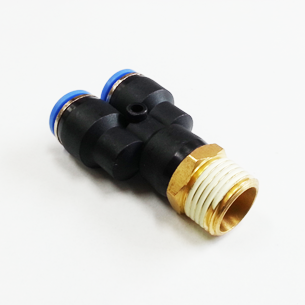
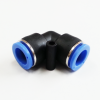


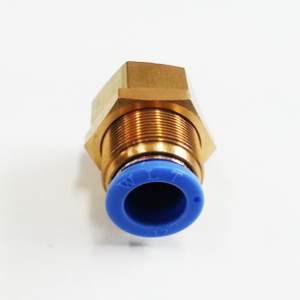
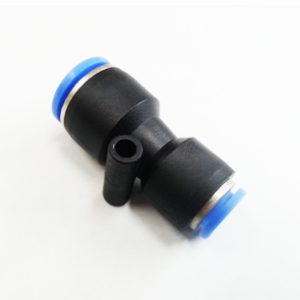
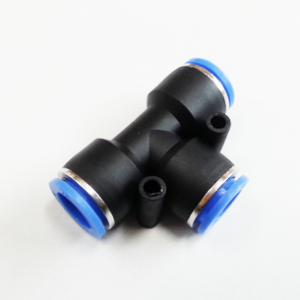
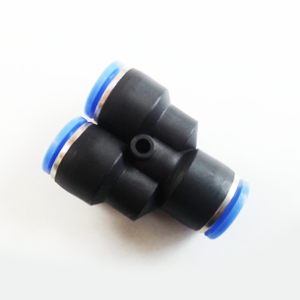
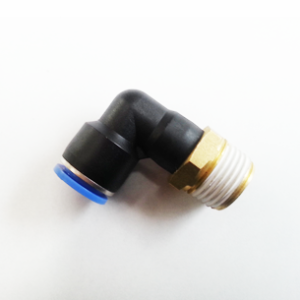
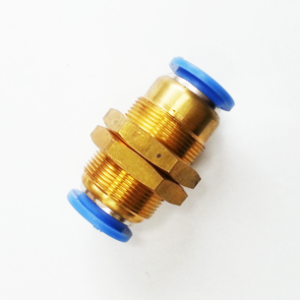
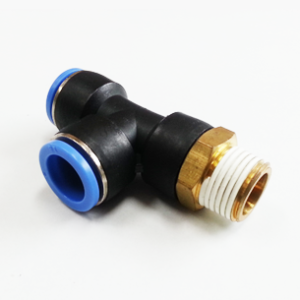
Reviews
There are no reviews yet.